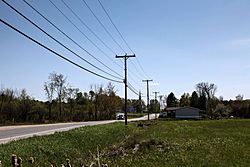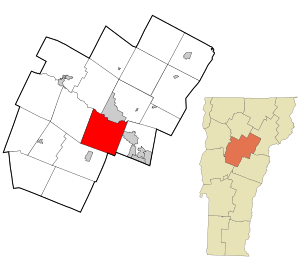Berlin, Vermont facts for kids
Quick facts for kids
Berlin, Vermont
|
|
|---|---|

"Berlin Corner", with the Congregational church on the hilltop
|
|

Location in Washington County and the state of Vermont
|
|
| Country | United States |
| State | Vermont |
| County | Washington |
| Communities |
|
| Area | |
| • Total | 36.9 sq mi (95.7 km2) |
| • Land | 36.3 sq mi (93.9 km2) |
| • Water | 0.7 sq mi (1.7 km2) |
| Elevation | 879 ft (268 m) |
| Population
(2020)
|
|
| • Total | 2,849 |
| • Density | 77.10/sq mi (29.770/km2) |
| Time zone | UTC-5 (Eastern (EST)) |
| • Summer (DST) | UTC-4 (EDT) |
| ZIP Codes | |
| Area code(s) | 802 |
| FIPS code | 50-05650 |
| GNIS feature ID | 1462042 |
Berlin (pronounced BUR-lin) is a town in Washington County, Vermont, United States. It was founded in 1763.
In 2020, about 2,849 people lived in Berlin. The town is located between Barre and Montpelier, which are the two largest cities in the area. Because of this, many businesses and shops for the region are found in Berlin, including parts of the Barre-Montpelier Road (U.S. Route 302) and the Berlin Mall.
Contents
History of Berlin
Berlin was officially created on June 8, 1763. Its name comes from Berlin, Germany. It was the only town in this new English colony to have a German name. The people who received the original rights to the land included priests, merchants, and judges.
The first settlers arrived 22 years later. Ebenezer Sanborn came from nearby Corinth. Joseph Thurber came from New Hampshire. Both of them left after a year to move to New York state.
In 1788, the state of Vermont decided that Berlin and several other towns would form one legal district. This district was called the district of Randolph.
Jacob Fowler was the first settler who stayed in Berlin and had children there. Other early settlers were Moses Smith, Daniel Morse, John Lathrop, and Hezekiah Silloway. By 1789, thirteen families lived in Berlin. In 1790, eight more families moved to the town. The first child born in Berlin was Abigail Black in 1789.
The first town meeting was held on March 31, 1791. In the same year, the first sawmill was built. The first school opened on East Street in 1794. The first Christian church was started in 1798. A Congregational meeting house opened in Berlin center in 1803. After it burned down in 1838, the Congregational Church was rebuilt at Berlin Corner. The first store and a place to eat opened around 1800 but closed in 1850.
People from Berlin
Many interesting people have come from Berlin. Here are a few:
- Eliada W. Brown – A member of the Wisconsin State Assembly.
- Merton Brown – A person who wrote music.
- Murdock A. Campbell – The top military officer for the Vermont National Guard.
- Thomas H. Cave – The person in charge of Vermont's money.
- Julius Yemans Dewey – A business leader and the father of a famous admiral, George Dewey.
- Ira Hobart Evans – He received a special award for bravery during the American Civil War. He also led the Texas House of Representatives.
- Timothy Dwight Hobart – A rancher in Texas.
- Chauncey L. Knapp – A representative for Massachusetts in the U.S. government.
- Clarence H. Pitkin – A lawyer for the U.S. government in Vermont.
- Phil Scott – The current Governor of Vermont.
Where is Berlin Located?
Berlin is a town with a total area of about 95.7 square kilometers (36.9 square miles). Most of this area, about 93.9 square kilometers (36.2 square miles), is land. The rest, about 1.7 square kilometers (0.7 square miles), is water.
Population of Berlin
The population of Berlin has changed over the years. Here's how many people have lived in Berlin during different census years:
| Historical population | |||
|---|---|---|---|
| Census | Pop. | %± | |
| 1800 | 684 | — | |
| 1810 | 1,067 | 56.0% | |
| 1820 | 1,455 | 36.4% | |
| 1830 | 1,664 | 14.4% | |
| 1840 | 1,598 | −4.0% | |
| 1850 | 1,507 | −5.7% | |
| 1860 | 1,545 | 2.5% | |
| 1870 | 1,474 | −4.6% | |
| 1880 | 1,380 | −6.4% | |
| 1890 | 1,514 | 9.7% | |
| 1900 | 1,021 | −32.6% | |
| 1910 | 1,079 | 5.7% | |
| 1920 | 959 | −11.1% | |
| 1930 | 992 | 3.4% | |
| 1940 | 1,111 | 12.0% | |
| 1950 | 1,158 | 4.2% | |
| 1960 | 1,306 | 12.8% | |
| 1970 | 2,050 | 57.0% | |
| 1980 | 2,454 | 19.7% | |
| 1990 | 2,561 | 4.4% | |
| 2000 | 2,864 | 11.8% | |
| 2010 | 2,887 | 0.8% | |
| 2020 | 2,849 | −1.3% | |
| U.S. Decennial Census | |||
In 2000, there were 2,864 people living in Berlin. There were 1,109 households, which are groups of people living in the same home. About 33.3% of these households had children under 18. The average age of people in Berlin was 41 years old.
Getting Around Berlin
Berlin has its own airport called Edward F. Knapp State Airport. There is also a train station in Berlin called Montpelier Junction. It is located on Junction Road.
Shopping in Berlin
Because Berlin is easy to reach from both Montpelier and Barre, many big stores are located here. The main shopping area is the Berlin Mall. It's a large indoor shopping center with over 25 shops. It is Vermont's third biggest mall.
There are also many other stores and restaurants along the Barre-Montpelier Road. You can find supermarkets, places to eat (both sit-down and fast-food), and car dealerships. The Wayside Restaurant is a well-known place to eat in Berlin.
Hospitals in Berlin
Central Vermont Medical Center is the main hospital in Berlin. It has 122 beds for patients and provides healthcare for about 66,000 people in central Vermont. The state's hospital for mental health, Vermont Psychiatric Care Hospital, is also located in Berlin. It opened after the old hospital in Waterbury closed due to flooding in 2011.
Library in Berlin
The Midstate Regional Library used to be in Berlin. It was one of two regional libraries run by the Vermont Department of Libraries. However, this library is now closed. The space where it used to be is now used by the Berlin Barracks of the Vermont State Police.
Images for kids
See also
 In Spanish: Berlin (Vermont) para niños
In Spanish: Berlin (Vermont) para niños






